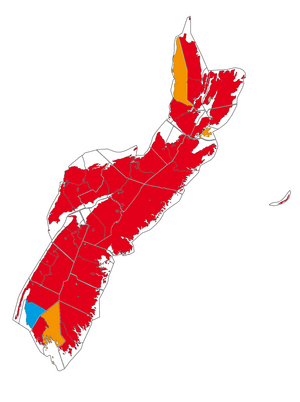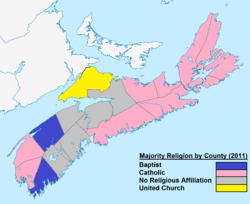Demographics of Nova Scotia facts for kids
Nova Scotia is a Canadian province on Canada's southeastern coast. Its name means New Scotland in Latin. In French, it's called French: Nouvelle-Écosse, and in Scottish Gaelic, Scottish Gaelic: Alba Nuadh.
Nova Scotia is the most populated province in Atlantic Canada. Its capital city, Halifax, is a very important economic center in the region. Nova Scotia is the second smallest province in Canada. It covers an area of 55,284 square kilometers. About 921,727 people live there, making it the fourth least populated province in the country.
Contents
Population in Nova Scotia
Nova Scotia is home to many people. In 2017, about 957,600 people lived here. This means about 17 people live in every square kilometer. About 60% of the people live in the countryside.
Main Cities and Towns
Nova Scotia has three main regional areas. These are like big cities that include nearby towns.
- Halifax is the largest regional municipality. It had over 403,000 people in 2016.
- Cape Breton is another large area, with about 94,000 people.
- Queens is smaller, with about 10,000 people.
The province also has 26 towns. Some towns, like Canso, Bridgetown, and Springhill, have joined larger counties or dissolved.
Many people live in "population centers." These are like urban areas. The Halifax population center is the biggest urban area in Nova Scotia.
How Nova Scotia's Population Grew
The number of people living in Nova Scotia has changed over time.
- In 1851, about 276,854 people lived here.
- By 1951, the population had grown to 642,584.
- In 2011, there were 921,727 people.
- By 2016, the population reached 952,298.
The population has generally grown, showing how the province has developed. Source: Statistics Canada
Diverse Communities
Nova Scotia is a diverse place with people from many backgrounds.
- Most people are of European background.
- Many people are part of visible minority groups. These include people from South Asia, China, and Black communities.
- Nova Scotia is also home to Aboriginal groups. These include First Nations and Métis people.
Languages Spoken
In Nova Scotia, people speak many different languages.
- The most common language is English. About 92% of people speak English as their first language.
- The second most common is French, spoken by about 3.4% of people.
- Algonquian languages, like the Mi'kmaq language, are also important. About 0.5% of people speak an Algonquian language.
- Other languages spoken include Arabic, German, and Chinese.
People Moving In and Out
People move to and from Nova Scotia.
- Between 1996 and 2006, about 45,195 immigrants moved to Nova Scotia.
- The most common countries they came from were the United Kingdom, the United States, and Germany.
- Many people also move between Nova Scotia and other parts of Canada.
- More people moved out of Nova Scotia to Alberta and Ontario than moved in from those provinces.
- However, more people moved to Nova Scotia from Newfoundland and Labrador and New Brunswick.
Religion in Nova Scotia
Many different religions are practiced in Nova Scotia.
- The largest religious group is Catholics, making up about 32.9% of the population.
- A significant number of people, about 21.8%, say they have no religious affiliation.
- Other large Christian groups include the United Church and Anglicans.
- There are also communities of Muslims, Buddhists, Hindus, and Jewish people.
Jobs and Income
Employment
As of February 2019, the unemployment rate in Nova Scotia was 6.4%. This means that 6.4% of people looking for jobs could not find one. In the Halifax area, the unemployment rate was lower, at 4.9%.
Income
The average income for households in Nova Scotia varies.
- In 2011, the average household income for all of Nova Scotia was about $53,606 per year.
- Halifax County had the highest average income, around $62,049.
- Other counties like Hants County and Antigonish County also had higher incomes.
- In terms of communities, Halifax Regional Municipality had the highest average income.
Economy
Nova Scotia's economy is strong. The total value of all goods and services produced in the province each year, called the GDP, is about $33 billion Canadian dollars.
Images for kids
See also
 In Spanish: Demografía de Nueva Escocia para niños
In Spanish: Demografía de Nueva Escocia para niños





